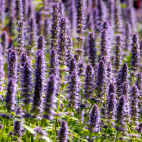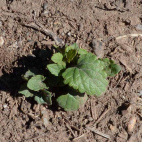Yellow Giant Hyssop Seeds
- HOW TO GROW
- FAST FACTS
- REVIEWS
HOW TO GROW
Sowing: Direct sow in the fall, pressing the yellow giant hyssop seeds into the surface of the soil. For spring planting, mix the seed with moist sand and store it in the refrigerator for 60 days before planting on the surface of the soil. To start indoors, plant on the surface of a flat with bottom heat of 70 degrees F and consistent moisture. Germination should take place within 6-10 days. As soon as the seedlings are big enough to handle and there is no chance of frost, they can be transplanted.
Growing: Keep young seedlings watered. Medium to moist soil is best for this plant, but the plant is somewhat drought tolerant once it reaches maturity and adapts to many types of soil. Plants will bloom the second year from seed. It reseeds itself readily, so if volunteer plants are not wanted deadhead the faded flower spikes. This plant attracts bees, hummingbirds, and butterflies.
Harvesting: Fresh leaves can be individually harvested for tea, salads, or medicinal use throughout the growing season; in the morning after the dew has dried is the best time for harvesting. Take individual leaves first from the bottom of the stem and work up to the top. Do not remove more than 60% of the plant at any one time. To harvest entire stalks for drying, cut them 2-3" from the ground and hang them upside down to dry.
Seed Saving: When the flower spikes begin to dry and turn brown, remove them and spread them out to dry; thresh them to remove the seed. Shaking the entire plant's Agastache Nepetoides seed heads into a container is also effective, but the process should be repeated daily until all the seed has matured. Store yellow giant hyssop seeds in a cool, dry place.
FAST FACTS
Latin Name: Agastache nepetoides
Species Origin: US Native Wildflower
Type: Native Wildflowers
Life Cycle: Perennial
USDA Zones: 4, 5, 6, 7
US Regions: Midwest, Northeast, Southeast
Seeds per Ounce: 90,000
Stratification: Cold/Wet for 8 Weeks
Germination Ease: Stratify 8 Weeks
Sunlight: Full Sun, Part Sun
Height: 72 Inches
Color: Cream, Yellow
Bloom Season: Blooms Late Summer, Blooms Early Fall
Uses: Attracts Pollinators, Attracts Honeybees, Attracts Butterflies, Hummingbirds, Aromatic, Cut Flowers, Dried Flowers, Deer Resistant
good germination
Seeds germinated well, there were enough seeds in the packet, thank you!
Surprise 4 years later
I purchased the Yellow Giant Hyssop seeds in 2012 and after a few attempts failed to get any seeds to germinate OR SO I THOUGHT.
Frustrated, I tossed the remaining seed into the backyard and forgot about them.
This spring 2016 seedlings began to pop up in my planters (where I originally tried to germinate them) and in the back yard where I tossed the remaining seed.
Since it had been YEARS since I purchased the seed I forgot what I had done and what they were but luckily I let the seedlings grow instead of chopping them down.
And WOW I now have what has to be 100 plants growing. The majority of the plants are thriving in what is heavy clay soil that rarely receives water and is subjected to HOT Texas summers.
I can not wait for the plants to bloom and hope that they get a chance to reseed. The native bees are in for a treat considering that this plant does not exist in my area.
Hence, patience seems to be key with this plant. LOTS of patience.
DESCRIPTION

HOW TO GROW
Sowing: Direct sow in the fall, pressing the yellow giant hyssop seeds into the surface of the soil. For spring planting, mix the seed with moist sand and store it in the refrigerator for 60 days before planting on the surface of the soil. To start indoors, plant on the surface of a flat with bottom heat of 70 degrees F and consistent moisture. Germination should take place within 6-10 days. As soon as the seedlings are big enough to handle and there is no chance of frost, they can be transplanted.
Growing: Keep young seedlings watered. Medium to moist soil is best for this plant, but the plant is somewhat drought tolerant once it reaches maturity and adapts to many types of soil. Plants will bloom the second year from seed. It reseeds itself readily, so if volunteer plants are not wanted deadhead the faded flower spikes. This plant attracts bees, hummingbirds, and butterflies.
Harvesting: Fresh leaves can be individually harvested for tea, salads, or medicinal use throughout the growing season; in the morning after the dew has dried is the best time for harvesting. Take individual leaves first from the bottom of the stem and work up to the top. Do not remove more than 60% of the plant at any one time. To harvest entire stalks for drying, cut them 2-3" from the ground and hang them upside down to dry.
Seed Saving: When the flower spikes begin to dry and turn brown, remove them and spread them out to dry; thresh them to remove the seed. Shaking the entire plant's Agastache Nepetoides seed heads into a container is also effective, but the process should be repeated daily until all the seed has matured. Store yellow giant hyssop seeds in a cool, dry place.
FAST FACTS
Latin Name: Agastache nepetoides
Species Origin: US Native Wildflower
Type: Native Wildflowers
Life Cycle: Perennial
USDA Zones: 4, 5, 6, 7
US Regions: Midwest, Northeast, Southeast
Seeds per Ounce: 90,000
Stratification: Cold/Wet for 8 Weeks
Germination Ease: Stratify 8 Weeks
Sunlight: Full Sun, Part Sun
Height: 72 Inches
Color: Cream, Yellow
Bloom Season: Blooms Late Summer, Blooms Early Fall
Uses: Attracts Pollinators, Attracts Honeybees, Attracts Butterflies, Hummingbirds, Aromatic, Cut Flowers, Dried Flowers, Deer Resistant
Reviews
Review
good germination
Seeds germinated well, there were enough seeds in the packet, thank you!
Review
Surprise 4 years later
I purchased the Yellow Giant Hyssop seeds in 2012 and after a few attempts failed to get any seeds to germinate OR SO I THOUGHT.
Frustrated, I tossed the remaining seed into the backyard and forgot about them.
This spring 2016 seedlings began to pop up in my planters (where I originally tried to germinate them) and in the back yard where I tossed the remaining seed.
Since it had been YEARS since I purchased the seed I forgot what I had done and what they were but luckily I let the seedlings grow instead of chopping them down.
And WOW I now have what has to be 100 plants growing. The majority of the plants are thriving in what is heavy clay soil that rarely receives water and is subjected to HOT Texas summers.
I can not wait for the plants to bloom and hope that they get a chance to reseed. The native bees are in for a treat considering that this plant does not exist in my area.
Hence, patience seems to be key with this plant. LOTS of patience.
Also Consider These:
-
 Anise Hyssop Seeds
Agastache foeniculum
A member of the mint family, this wildflower brings a delightfully rich scent to any herb garden. The tall, lavender flower spikes attract multitudes of hummingbirds, bees, and butterflies. It is a favorite with beekeepers, and we have found that the anise honey from this plant is excellent!Quick Viewx
Anise Hyssop Seeds
Agastache foeniculum
A member of the mint family, this wildflower brings a delightfully rich scent to any herb garden. The tall, lavender flower spikes attract multitudes of hummingbirds, bees, and butterflies. It is a favorite with beekeepers, and we have found that the anise honey from this plant is excellent!Quick ViewxAnise Hyssop Seeds
Agastache foeniculum
A member of the mint family, this wildflower brings a delightfully rich scent to any herb garden. The tall, lavender flower spikes attract multitudes of hummingbirds, bees, and butterflies. It is a favorite with beekeepers, and we have found that the anise honey from this plant is excellent!
$3.48 Pkt - $16.57 / Oz -
 Purple Giant Hyssop Seeds
Agastache scrophulariaefolia
This lovely, tall wildflower adds beauty and color to meadows and gardens. In addition, it is a wonderful honey plant - the fragrant foliage is irresistible to birds, bees, and butterflies.Quick View$3.48 Pkt - $36.00 / Oz
Purple Giant Hyssop Seeds
Agastache scrophulariaefolia
This lovely, tall wildflower adds beauty and color to meadows and gardens. In addition, it is a wonderful honey plant - the fragrant foliage is irresistible to birds, bees, and butterflies.Quick View$3.48 Pkt - $36.00 / Oz










